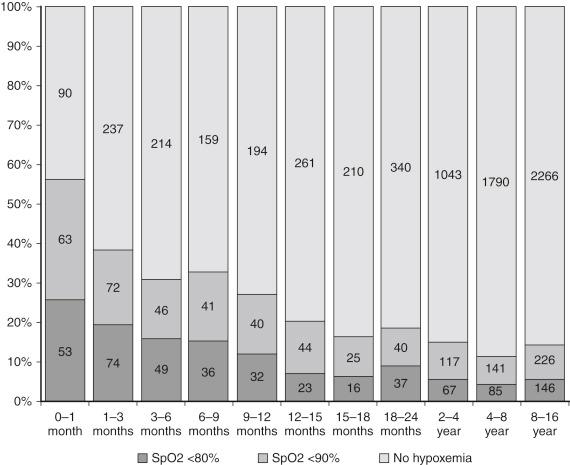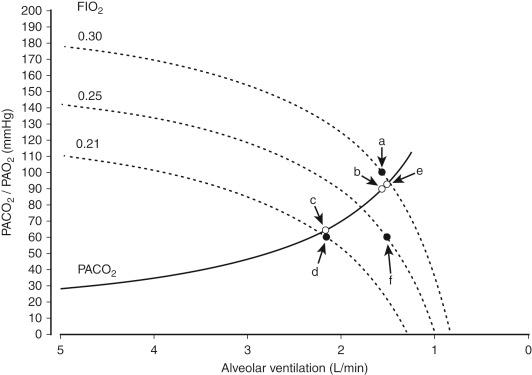Physical Address
304 North Cardinal St.
Dorchester Center, MA 02124
An otherwise healthy 5-year-old girl with adenotonsillar hypertrophy secondary to recurrent infections underwent an uneventful tonsillectomy and adenoidectomy with general anesthesia, was extubated, and was sent to recovery. The recovery nurse notifies you that the patient is stridulous with retractions. Cyanosis, tachycardia, and percutaneous arterial oxygen saturation (Sp o 2 ) less than 60% are noted.
Hypoxemia is defined as an abnormally low concentration of oxygen in the blood. This differs from hypoxia, which is a state of inadequate oxygen delivery to tissues resulting in the inability to sustain normal cellular aerobic metabolism. Normal age-related values of arterial oxygenation (Pa o 2 ) are found in Table 192.1 . Oxygen affinity of hemoglobin changes with age, after the transition from fetal to adult hemoglobin and eventual decrease in 2,3-diphosphoglycerate (2,3-DPG) levels ( Table 192.2 ).
| Age | Pa o 2 (mm Hg) |
|---|---|
| Preterm | 60 |
| Full term | 70 |
| 1 month | 95 |
| 1 year | 93 |
| 12 years | 98 |
| Age | Pa o 2 (mm Hg) a |
|---|---|
| Neonate | 20 |
| Infant (>3 mo) | 30 |
| Adult (>18 yr) | 27 |
a Oxygen affinity is highest in the neonate and lowest in the infant before reaching adult levels.
According to the Pediatric Perioperative Cardiac Arrest (POCA) Registry, 27% of cardiac arrests were due to respiratory causes, primarily laryngospasm, most often occurring during the postsurgical phase of care. Intraoperative hypoxemia in children is associated with younger age ( Fig. 192.1 ). Thus it is imperative to recognize adverse respiratory events and treat hypoxemia expeditiously in children undergoing anesthesia.

The pulse oximeter has become the standard of care for oxygen saturation monitoring, improving patient safety in anesthesia by allowing the provider the opportunity to respond sooner to desaturation than would be recognized by clinical signs alone. Pulse oximetry can measure the adequacy of oxygenation, but can only assess ventilation in the absence of supplemental oxygen. Even small amounts of supplemental oxygen will mask hypoventilation (rise in Pa co 2 ) by allowing for a less significant drop in Pa o 2 , making capnography important as well ( Fig. 192.2 ).

Clinical signs of hypoxemia, which vary with age, must also be recognized. Preterm infants and neonates tend to respond to hypoxemia with respiratory depression and bradycardia, whereas older infants and children respond with tachypnea and either tachycardia or bradycardia. Other more global clinical signs of hypoxemia include cyanosis, pallor, restlessness, or altered mental status, many of which are masked by anesthesia. Upper airway obstruction signs include stridor, grunting, retractions, nasal flaring, and ventilatory effort without air movement. Lower airway obstruction signs include wheezing, rhonchi, and decreased breath sounds. Both can lead to no air movement, making differentiation difficult.
Determining the cause of hypoxemia is critical to establishing a treatment strategy. A systematic approach to ascertaining the etiology must be taken. In addition to physical assessment, one might take a “wall to the alveoli” approach, assessing oxygen supply, integrity of the anesthesia machine and circuit, and the patient’s airway before laboratory evaluation. The physiologic impact of other organ systems (i.e., pulmonary, cardiovascular, hematologic, central nervous systems) should also be considered.
The risk of hypoxemia in pediatric patients is related to many factors, including age, anatomic and physiologic characteristics, and underlying disease. The anesthesiologist must assess the degree these risks will contribute to hypoxemia in an individual patient. Box 192.1 lists the principal causes of hypoxemia. In fact, the incidence of hypoxemia increases with decreasing age, and is highest in the neonatal population (see Fig. 192.1 ).
Apnea
Head trauma
Brain tumor
Seizures
Impaired medullary perfusion/increased intracranial pressure
Anesthetic agents
Opiate overdose
Inhalation agents
Barbiturates, sedatives
Combination of the above
Epiglottitis, croup
Tracheomalacia, laryngomalacia
Retropharyngeal abscess
Vascular ring
Infantile stridor
Laryngospasm
Webs
Mediastinal mass
Foreign body, ETT obstruction
Thermal airway injury (burns)
Subglottic stenosis
Upper respiratory infection
Become a Clinical Tree membership for Full access and enjoy Unlimited articles
If you are a member. Log in here